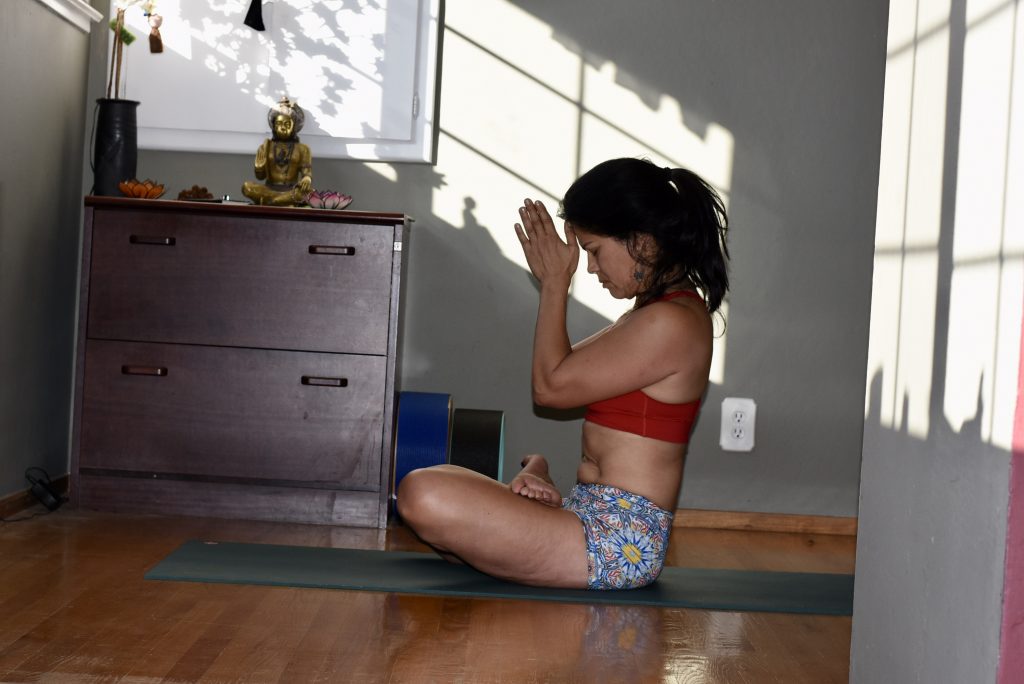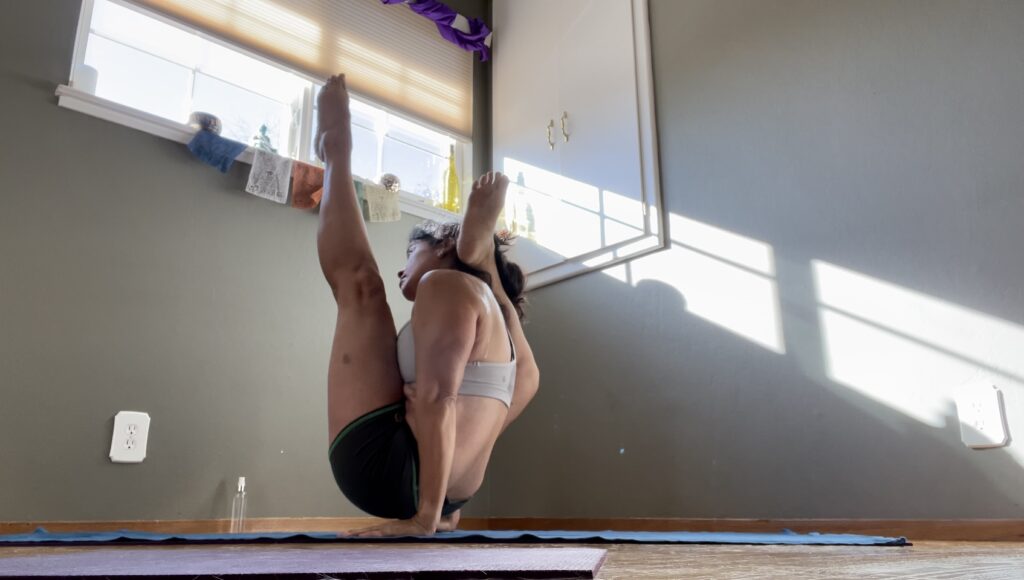energy shifts
Asanas and Aparigraha
Practitioners of the ashtanga yoga are accustomed to working on their “given” poses until their teacher feels they are ready to add the next pose. A lot goes into this assessment. It’s more than just a mastery of the poses they’ve already been practicing daily. It’s an assessment of dedication, concentration, prior injuries, and overall endurance – among other things. Depending on the next pose, the practitioner may be eager to move on OR they may be hesitant. It is not unusual to be stuck on trying to master a given pose for many years.
It is also not unusual to be stuck on the fact that you haven’t been given the next pose.
While you may fear that you may pass on before being given poses later in the sequence you are working on, one may ask, “Why does it matter?” If you die without ever getting to practice the 7 handstands at the end of intermediate series (aka “the 7 deadlies”), people won’t think any less of you. In fact, they may be less likely to think of you as that crazy lady who used to put her legs behind her neck and do a bunch of funny headstands.
“Let your concern be with the action alone, and never with the fruits of action. Do not let the results of your action be your motive, and do not be attached to inaction” – Krishna
sthira bhaga
While LIVE on our Mysore ZOOM, I flow through my morning practice with an acute awareness that my teacher is watching. Not only is she watching, she is waiting for me to finish up my second series already so that she can see what progress I’ve made in the third series poses she gave me last week.
But my practice is slow today and my coffee has yet to kick in. Gasp if you wish; I don’t care what you think. I NEED my COFFEE.
As I lay on my back, working to place my lower leg behind my shoulders, I notice the moon through the window in front of me. In the window of the adjoining bedroom, I can also see the sun’s blessed light. It’s lovely and a part of me wants to spend another 5-10 breaths in yoga nidrasana. But then I remember my teacher. She’s watching. I hear her call the name of one of the other students. The last time she called his name, he was at pasasana, and I was 3-4 poses ahead in the series. I can tell by her words that he is now working on pincha mayurasana. It is clear that today’s practice has not been flowing as steadily as it should. I suppose the time I spent crying BEFORE going into kapotasana slowed me up…a little. Yeah, that was unexpected.
*sigh*
“Okay Juls,” I tell myself (quietly, as my computer is no longer on mute), “just breathe and get moving.” I limp along to the end of second and arrive at third with 30ish minutes until my work meeting. I am sore but have more energy today than last week. I might go well. I mean, miracles DO happen. Right!
WRONG!
Third Series has been described as “Divine stability; sublime serenity.” Reading this description sure makes it sound nice. Right? And, it IS nice. But it’s also HARD. The journey to this point is far from stable or serene (without the added pressure of having it be divine or sublime on top of that). I’m not complaining; I asked for this and I am happy to take it on. Lord knows my side body is weak and could benefit from a little stability – and serenity. My teacher knows this as well.
Nonetheless, I must admit that the difficulty that I am experiencing feels foreign yet satisfying. It feels right to finally be working on creating stability in the side body. And although there are moments when I question if I really deserve to be have these poses, I am super grateful that my teacher has allowed me to go here.
Gratitude Practice
Whether I roll out my mat at the studio or at home, my focus is the same. It is one of gratitude. Yoga is a feeling practice. There is so many other feelings and emotions swirling around in my body and mind but these emotions are the ones I am bringing into focus. As I bring my attention to what is right in my life, the fear, uncertainty, pain, and other feelings fall away.
I am grateful for this beautiful life, my health, my sons’ (lives, love, health, happiness…), the close relationships with my extended family, our dog, my home, job, my practice, and the opportunity to share yoga to others (among so much more).

I invite you try it yourself. It is hard to be fearful when you are focused on gratitude. You may notice that, while in a state of gratitude, it is far easier to make important decisions, create a vision for what you want to manifest, or simply just enjoy the moment.
expectations
One morning, while en route to yoga, I questioned why I was even going. My body ached something fierce and my mind was far from finding acceptance with how I was feeling. It was hard not to set an expectation for a “bad practice.” I reminded myself to have an open mind and not judge what was to come. After all, that *is* the point of the practice: the same sequence of poses, done in the same order, 6 days per week unfolding in a new way each time.
The radio played as I creeped along the freeway. I shook my head, surprised to find traffic so heavy this early in the morning. Ahead of me, the clouds (both dark and light), caught just a hint of the sunlight. It was beautiful and immediately made me feel grateful to have slowed down just enough to notice. Just like that, my mind shifted and I smiled thinking how easily the bad can be turned into something just a little bit better.
As for my practice, I do not recall how far into it before I became aware that I was no longer feeling any signs of discomfort. I guess, like the sunlight behind the clouds, the body to which I awakened also had a few surprises for me. A short while later, even though the pain had left, I told my teacher that I wasn’t sure how deep of a kapotasana I had to offer. A few deep slow breaths into the pose, I felt a sudden wave of release. She had said, “Let go,” and so I did. I let go of fear, my need to protect my heart, and I let go of expectations…at least for a time. And this too was new, for I’ve been holding on to a lot lately.
Learning to Count
During my preparation to teach the class that would ultimately decide if I was certification-worthy or not, I began working on learning the traditional vinyasa count in Sanskrit. Over the years, I have committed to learning the Sanskrit name of the poses in my given practice. For me, it is part of the practice; in a sense, learning the name is like taking ownership of the pose. Although I have made a point to know when and where the inhalations and exhalations occur, learning the traditional count was never something I felt compelled to learn.
Until… I was asked to substitute teach the Led Primary class at a newer yoga studio in the Bay Area. The led class occurs weekly at many studios and serves as a complement to the students’ regular Mysore practice. While the student follows their own breathing pattern during their Mysore practice, they learn efficiency when asked to keep their practice married to the teacher’s count (which may be faster or slower than their usual pace). In this led class, the teacher calls out the names of the poses in Sanskrit along with traditional vinyasa count and, often, not a lot of other verbal cuing. Because the student already knows the sequence, there doesn’t need to be a lot of other direction.
So, I set out to learn it, naïve to the complexity that I would soon face. I quickly learned that it is not as easy as 1-2-3… There are poses which used to begin with a full vinyasa beginning from ekam (1) standing at the top of the mat, arms rise, and so on. These poses now have only a half vinyasa where the count begins with the student jumping through to seated from adho mukha svanasana (downdog) and therefore the count begins at sapta (7). That was the least of my confusion. There were other instances where the count reverted back somewhere in the previous number sequence, sometimes repeatedly, other times only once. After a few days of carefully reviewing various recordings and writings of the practice, I became completely overwhelmed to the point of tears. It wasn’t until my teacher shared with me that “traditional” count was not at all traditional in the sense that every teacher doesn’t call it out exactly the same. She advised me to just learn when and where the inhale and exhale goes for the test out and even upcoming the led class. Then, keep working on learning the count and, over time, it will come.
And, while I don’t believe that learning the vinyasa count makes you any better of a student, I wonder if learning it somehow energetically creates a stronger bond to the flow of the practice in a similar way to my commitment to learning the names of the poses as a way to “own” the poses that are part of MY practice. It’s just a thought. What do YOU think?

